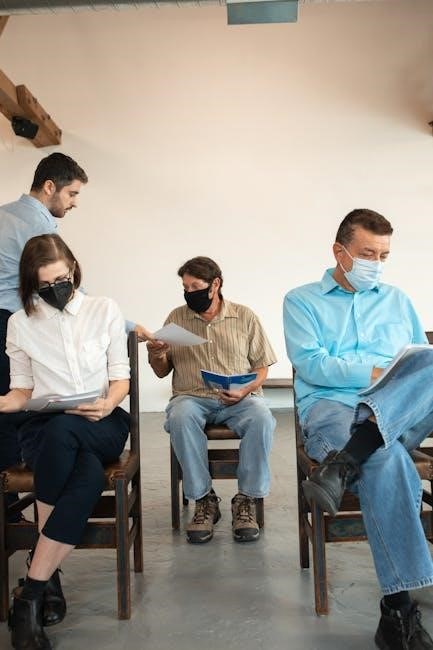Flea Bomb Instructions: A Comprehensive Guide
A flea bomb, or fogger, is a potent insecticide designed to eliminate fleas within an enclosed area. It releases a fog or mist containing chemicals that kill fleas on contact. They are ideal for large spaces, but require careful preparation and safety precautions as some leave residue on carpets and furniture.

What is a Flea Bomb and How Does It Work?
A flea bomb, also known as a flea fogger, is a device designed to release insecticide into an enclosed space to eradicate fleas. It works by dispensing a mist or fog containing chemicals like permethrin, which targets the fleas. The fog permeates the air, reaching into cracks, crevices, and other hard-to-reach areas where fleas may be hiding.
Once released, the insecticide settles on surfaces, killing adult fleas and, in some cases, flea larvae and eggs. Some flea bombs contain ingredients that disrupt the flea life cycle, preventing immature fleas from developing into adults. This is crucial for breaking the flea breeding cycle. The effectiveness of a flea bomb depends on factors such as the size of the space being treated, the concentration of the insecticide, and the thoroughness of preparation before deployment.
Flea bombs are often used as part of a comprehensive flea control strategy, along with vacuuming, washing bedding, and treating pets with appropriate flea medications. While flea bombs can be effective, they require careful adherence to safety precautions to protect human and animal health.
Preparing Your Home Before Setting Off a Flea Bomb
Before deploying a flea bomb, thorough preparation is essential for maximizing its effectiveness and ensuring safety. Begin by calculating the square footage of the area you intend to treat to determine the appropriate number of foggers needed. Remove all people, pets, and plants from the premises, including fish tanks. Cover or remove any exposed food items, dishes, and utensils to prevent contamination.
Wash all bedding, curtains, and washable fabrics that may harbor fleas. Vacuum carpets, rugs, and upholstered furniture to remove fleas, eggs, and larvae. Pay special attention to areas where pets spend the most time. Clear clutter from floors, closets, and under furniture to allow the fog to penetrate all areas.

Open all interior doors, drawers, and cupboards to ensure that the insecticide reaches hidden spaces. Turn off all ignition sources, such as pilot lights and gas valves, to prevent fire hazards. Seal any cracks or openings to adjacent areas you do not want to treat. Following these steps will create an environment conducive to successful flea eradication.

Step-by-Step Instructions for Flea Bomb Deployment
Once your home is prepared, carefully follow these steps to deploy your flea bomb effectively. First, read the manufacturer’s instructions on the flea bomb packaging thoroughly. Place each flea bomb in the center of the area you want to treat, preferably on a heat-resistant surface like a biscuit tin lid or old plate. This prevents potential damage to flooring.
Activate the flea bomb according to the product instructions. Most flea bombs require you to press down on a nozzle or pull a tab to release the fog. Once activated, immediately exit the premises, taking pets and plants with you. Ensure that everyone, including neighbors, is aware of the flea bombing and avoids the area.
Allow the flea bomb to work for the time specified on the packaging, typically two to four hours. During this time, the insecticide will penetrate cracks and crevices, killing fleas on contact. After the recommended time, return to your home to begin the ventilation process. It’s crucial to adhere to safety guidelines to protect yourself and others.

Safety Precautions During and After Flea Bombing
Safety is paramount when using flea bombs. Before deploying, ensure all people and pets are removed from the premises. Fish tanks should be covered tightly and aerators turned off to prevent contamination. Never remain in the house while the flea bomb is active, as exposure to the chemicals can be harmful.
After the recommended treatment time, ventilate your home thoroughly by opening all windows and doors. Allow fresh air to circulate for at least two hours, or longer if a chemical odor persists. This will help dissipate any remaining insecticide. Avoid touching surfaces until they have been properly cleaned to minimize skin contact with residual chemicals.
Wash all bedding, curtains, and clothing that may have been exposed to the flea bomb. Clean countertops and other surfaces with a household cleaner to remove any lingering residue. If you experience any adverse reactions, such as skin irritation or respiratory issues, seek medical attention immediately. Always prioritize safety to protect yourself and your family.
What to Do After the Flea Bomb: Cleaning and Ventilation
Once the flea bomb has been deployed and the recommended time has elapsed, thorough cleaning and ventilation are crucial steps. Begin by opening all windows and doors to allow for maximum airflow. This helps dissipate any lingering chemical fumes and ensures a safer environment. Aim to ventilate for at least two hours, or longer if a strong odor persists.
Next, focus on cleaning surfaces that may have come into contact with the flea bomb’s residue. Wipe down countertops, tables, and other hard surfaces with a household cleaner. Launder all bedding, curtains, and clothing that were in the treated area. Vacuum carpets and upholstery thoroughly to remove any dead fleas, larvae, and eggs.
Pay special attention to areas where pets spend a lot of time, such as pet beds and blankets. Wash these items in hot water and dry them on high heat to kill any remaining fleas. After cleaning and ventilation, monitor the treated area for any signs of flea activity. Repeat the flea bomb treatment if necessary, following all safety precautions.
Combining Flea Bombs with Other Flea Control Methods
While flea bombs can be effective at eradicating adult fleas, they often fall short of eliminating the entire infestation. For comprehensive flea control, it is best to combine flea bombs with other methods. Vacuuming regularly is essential for removing flea eggs, larvae, and pupae from carpets, upholstery, and cracks in the floor. Focus on areas where pets spend the most time.
Treating your pets with flea medication is crucial to prevent re-infestation. Consult your veterinarian for the best flea treatment options for your pets. Washing pet bedding regularly in hot water is also important. Consider using flea sprays or powders in conjunction with flea bombs. These products can target fleas in hard-to-reach areas.
Steam cleaning carpets and upholstery can help kill fleas, larvae, and eggs that flea bombs may miss. Remember that flea bombs work by shooting material up high and letting it fall down. This ensures a multi-pronged approach.
Addressing Hidden Areas: Crevices and Under Furniture
Flea bombs often struggle to reach fleas hiding in crevices and under furniture. Flea bombs work by shooting material up high and letting it float down. This method wont reach underneath your furniture or other hidden spots. To effectively combat flea infestations, these areas must be addressed directly. Use the crevice and brush tool to reach hidden areas of your home that the flea bomb cant reach.
Consider using a spray or aerosol insecticide specifically designed for spot treatments. Apply the product to cracks, crevices, baseboards, and underneath furniture. Pay close attention to areas where pets frequently rest or sleep. Vacuuming is also essential for removing fleas and their eggs from these hidden spaces.
Move furniture to access hard-to-reach areas. Regularly wash or replace pet bedding to eliminate flea breeding grounds. By targeting these often-overlooked spots, you can significantly improve the effectiveness of your flea control efforts and prevent re-infestation.
Choosing the Right Flea Bomb: Brands and Ingredients
Selecting the appropriate flea bomb is crucial for effective flea control. Begin by researching reputable brands like Raid, Hot Shot, and Advantage; Check with friends and family for their opinions on the effectiveness of a flea bomb they might have used, or check online for fe. Always read the instructions and ingredients of a flea bomb before using it. Purchase a quality brand flea bomb. Ask your veterinarian for his or her advice on which products they recommend.
Consider the active ingredients, such as permethrin or pyriproxyfen. Permethrin kills adult fleas, while pyriproxyfen is an insect growth regulator that prevents flea larvae from developing into adults and breaks the flea breeding cycle ensuring fleas in their egg or larval stage are unable to mature into adult biting fleas.
Opt for a flea bomb that targets both adult fleas and their eggs to disrupt the flea life cycle. Evaluate the size of the area you need to treat and choose a flea bomb with adequate coverage. Read customer reviews to assess the product’s effectiveness and safety.
Disposal of Used Flea Bombs
Proper disposal of used flea bombs is essential for environmental safety. After the flea bombing process, allow the treated area to ventilate thoroughly for the time recommended on the product label. Once the space is well-ventilated and deemed safe, you can proceed with discarding the used flea bombs.
Carefully inspect the flea bomb canister to ensure it is completely empty. If there is any residual liquid or propellant, do not puncture or incinerate the container; Instead, contact your local waste management authority for guidance on how to dispose of hazardous materials safely. In many areas, there are designated collection sites or special disposal events for household hazardous waste.
If the flea bomb is empty, you can typically dispose of it in your regular trash. However, it’s always a good idea to check with your local waste disposal guidelines to ensure compliance with any specific regulations. When placing the used flea bomb in the trash, consider wrapping it in a plastic bag to prevent any potential leakage or contamination.